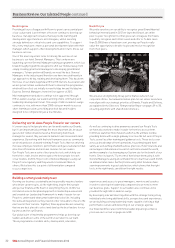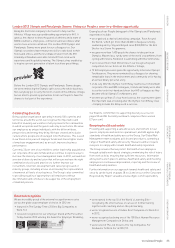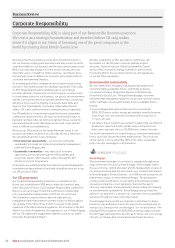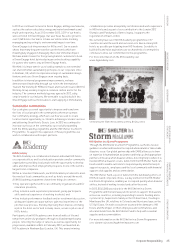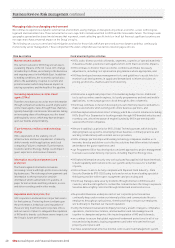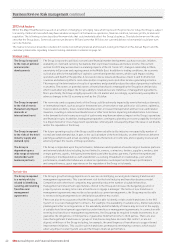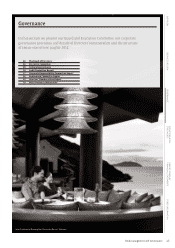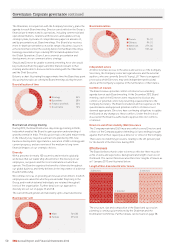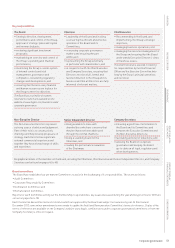Holiday Inn 2012 Annual Report Download - page 43
Download and view the complete annual report
Please find page 43 of the 2012 Holiday Inn annual report below. You can navigate through the pages in the report by either clicking on the pages listed below, or by using the keyword search tool below to find specific information within the annual report.
Risk management 41
Risk description Control and mitigation activities
Safety, security and crisis management
There is a constant need to protect the safety
and security of our guests, employees and assets
against natural disasters and man-made threats.
These include, but are not limited to, exceptional
events such as natural catastrophes, civil or
political unrest, violence and terrorism, fire and
day-to-day accidents and incidents which impact
the guest experience. The external risk
environment over the last few years appears
to be increasing – we have seen an increase in
extreme weather and civil and political unrest.
Furthermore, IHG’s growth in emerging markets
may increase the Group’s exposure to the risk of
civil and political unrest.
• IHG’s proactive, risk-based approach to hotel safety and security is summarised
below in the ‘Managing risks in hotels’ section;
• IHG’s hotel-level safety solutions combine measures to protect the physical
building and processes and procedures to ensure guest and employee safety; and
• IHG has strengthened the Group’s crisis management capability in 2012, including
the upgrading of the crisis call centre, refreshing our internal toolkit and eLearning
course and strengthening the network of crisis coordinators.
Managing risks in hotels
IHG’s commitment to risk management safety, security and crisis management in hotels remains fundamental to it being a Responsible
Business. We recognise the difference between a safe hotel and one which is poorly designed or operated. Therefore we require all hotels
to become compliant with a set of global Brand Safety Standards.
IHG’s approach has been to enable and support our hotel owners, General Managers and hotel employees to manage risk effectively. This is
accomplished by giving them a systematic approach and framework to follow and by providing them with user-friendly tools to do this. In 2012,
over 50,000 employees used our web-based risk management tools, which include a comprehensive suite of risk management, safety and
security training aligned to different roles and competency levels and have reached over 17,000 enrolments.
Hotel Safety Framework
The Hotel Safety Framework enables a consistent approach to
managing safety and security risk in IHG hotels. The framework
is illustrated by showing two mechanical cogs meshed together
showing different types of safety and security risks in the ‘Safe
Hotel’ cog, against the actions described in the ‘Manage Risk’
cog. This framework is actively managed by IHG’s risk managers
around the world, working with hotels and their management
teams in order to keep IHG hotels safe and secure. Safety and
security is an essential element of being a Responsible Business
and our Hotel Safety Framework underpins our hotel operations.
A hotel risk profile is also developed through various methods,
including self-assessment, guest satisfaction surveys, design and
engineering plans, incidents, intelligence gathering, quality audits
and risk management reviews. Hotel management teams discuss
issues at monthly safety meetings and action plans are developed.
Risks are prioritised, responsibility is assigned and improvement
actions are identified, progressed and monitored. Action plans are
reviewed at appropriate levels throughout the organisation for
issues that need to be escalated, either to drive action or to
develop common solutions.
External recognition
• IHG’s risk management training programme was awarded the
Best Risk Training Programme in 2012 by the StrategicRISK
European Risk Management Awards;
• we were awarded the Bronze award for the Best Use of
Technology in Learning in the 2012 Training Journal Awards; and
• IHG remains a corporate member of the Chartered Institute of
Environmental Health (CIEH), reflecting the Group’s commitment
to high standards of environmental health and it offers some
safety training programmes which are accredited by the CIEH.
Security
Crisis &
Incident
Fire
Safety
Leisure
Safety
Guest
Safety
Food
Safety
Staff
Safety
Risk
Profile
Policy &
Standards
Review
& Report
Ways of
Working
Risk
Financing Training &
Comms
Operate
& Control
M
a
n
a
g
e
R
i
s
k
S
a
f
e
H
o
t
e
l
OVERVIEW BUSINESS REVIEW GOVERNANCE
GROUP FINANCIAL
STATEMENTS
PARENT COMPANY
FINANCIAL STATEMENTS OTHER INFORMATION



